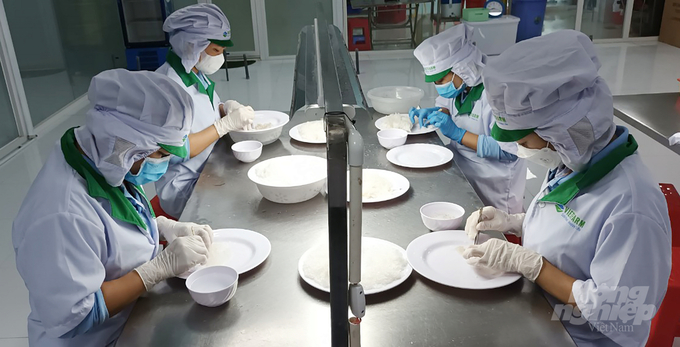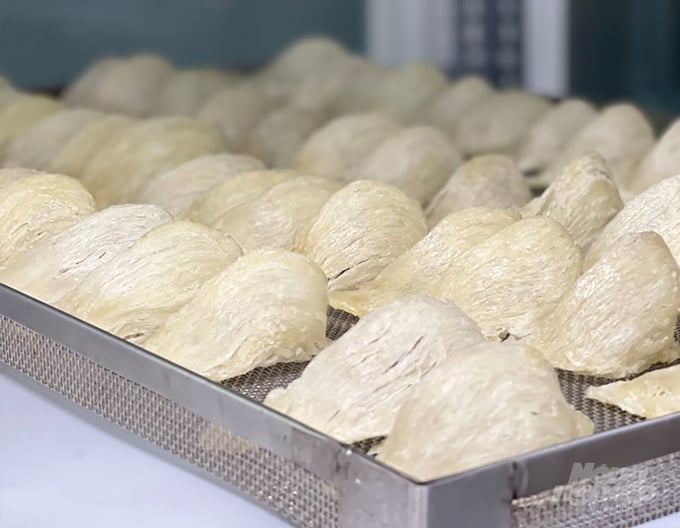
Workers provisionally process oats at GC Food Joint Stock Company’s VietFarm factory. Picture: N.T.
No bird flu for 12 months
According to Ms. Tran Thi Thu Phuong, head of the Department of International Cooperation and Communication (Department of Animal Health, Ministry of Agriculture and Rural Development), the protocol on exporting bird nests to China includes 16 articles on regulations for birdhouse nest, bird nest processing enterprises, export enterprises , packaging, labeling, quarantine, inspection, disease surveillance and food safety requirements.
Regarding the requirements for bird’s nest products, it must be a product formed/manufactured from birds’ saliva that has been cleaned of dust and feathers and be safe for the consumer. The product needs to be heat treated to ensure the product core temperature reaches 70 degrees Celsius for at least 3.5 seconds. At the same time compliance with the standards in Annex VII, Decree 13/2020/ND-CP and Chinese standards.
Bird nest products must come from bird nests that are registered with the relevant authorities and monitored by the veterinary authorities. Not belonging to provinces with avian influenza within 12 months from the date of export. Products from processing companies registered and approved by the General Administration of Customs of China. Meet China’s product labeling and packaging requirements…
Ms. Phuong pointed out that export products that do not meet the requirements of the protocol are detained, processed, returned or destroyed by the General Administration of Customs of China.
For swiftlet breeding farms, they need to register with the relevant authority and submit the list to the General Administration of Customs of China. Must be monitored by veterinary authorities for bird flu and Newcastle disease. There are books that record the diary of swift rearing and nest harvesting. Must be checked by the veterinary authority during the process of harvesting and transporting the nests to the processing plant.
For companies that process oats, this must be assessed and monitored by the Department of Animal Health. There must be a traceability system from the bird’s nest to the exported product. Have an effective heat treatment system and a quality management system (e.g. HACCP, ISO…). In addition, it must be registered with the General Administration of Customs of China under Order 248 and approved by the Chinese side.
Mr. Tong Xuan Chinh, deputy director of the Department of Animal Husbandry, Ministry of Agriculture and Rural Development, said that the opportunity for breeding swiftlet nests has come, but stricter management is needed, the product must meet the requirements of the Ministry of Agriculture and rural development requirements and conditions of your country. Organizations breeding bird nests are required to report and register with the municipal administration, carry out assessment and quality control, carry out registration procedures with the administrative authority …
“The growing area for swiftlets must be legal according to the planning approved by the provincial people’s committee. At present, the provinces have taken steps towards its implementation, but progress is still slow, only 26 provinces have issued a resolution on planning breeding area. Swiftlet,” Mr Chinh said.
Mr. Nguyen Van Long, Director of Department of Animal Health, noted that companies, associations and institutions should review all their production conditions and study the protocol carefully to implement the next steps, meet the standards and start exporting bird’s nest to China officially to continue . At the same time, organize public monitoring of bird flu.
For communities, Long said, there is a need to advise relevant authorities to develop the bird’s nest industry in a sustainable manner, while guiding, monitoring and assisting companies in implementing the decree. If you don’t prepare now, the above information and data will ensure disease management and surveillance, especially avian influenza and Newcastle disease. Implement food safety monitoring. All must have an information and data management system to ensure traceability and retrieve local and business-related issues. “The most important thing is to register in the Chinese system,” Long said.

The Chinese side requires all Vietnamese birdhouses to have identification codes for traceability. Picture: MRS.
From a business point of view, Mr. Le Duy Minh, chairman of the Vietnam Association of Farms and Agricultural Enterprises, estimated that Vietnam’s oats have great potential compared to other countries, and the growth rate of swiftlet agriculture has also increased significantly. The signing of the protocol on the official export of bird nests to China will help organize swift farming more professionally and sustainably.
The problem of identifying the code of the bird’s nest must be solved
According to Mr. Le Thanh Dai, chairman of the Vietnam Salanganes’Nest Association, the signing of the protocol on bird nest exports by the two countries is an opportunity to reaffirm the position and value of Vietnam’s bird nest. However, in order to achieve this, Dai said that individuals, units and companies in the bird nest industry must invest in science and technology and more modern, scientific and scientific procedures, and learn more to meet the needs of the Chinese side.
To prepare for the official process of exporting bird nests to China, Dai said the association has also trained swift house owners in the knowledge of managing and operating an effective swift house. At the same time, the association also organizes training on food safety and industrial hygiene to ensure that the bird’s nest for farmers and bird’s nest products are clean and safe, and in particular how to safely transport bird’s nests Food safety.
At the same time, the Vietnam Salanganes’Nest Association signed a program with the Central Veterinary Inspection Center II to quarantine and monitor food safety and hygiene for the export-qualified swift stalls. The association is also working with the Ministry of Animal Health and regional animal health sub-departments to carry out a program to monitor the operation of the bird’s nest according to Chinese standards to prevent diseases and insects from affecting the quality of the nest.
“We are also building provincial farms that focus on bird nest management based on the association’s model to create high quality products. The association is also working with a number of companies to set up bird nest product processing and finishing factories in accordance with HACCP and ISO standards to meet export demand with large capacity and in a closed process of the bird nests,” informed Mr. Le Thanh dai
However, the president of Vietnam’s Salanganes’Nest Association said the current difficulty is that the Chinese side requires all bird nest houses to have identification codes for traceability. Meanwhile, in the past 10 years, 80% of the quick rental houses have developed mainly according to spontaneous needs, without any regulations on legal procedures.
“Recommend the relevant authorities, especially the provincial and municipal people’s committees, to soon recognize the existing aviary farms that meet the requirements and are suitable for the function of the swift house, in order to have a legal basis to implement this program.” President of the Vietnamese Salanganes’Nest Association.
Deputy Agriculture and Rural Development Minister Phung Duc Tien stressed that Vietnam has joined 17 new-generation Free Trade Agreements (FTAs), so we must sell what the market needs, not what we need. Therefore, the criteria required by the protocol must be met, in particular the need to monitor Newcastle disease and H5N1. These are two diseases that still exist in Vietnam.
It is known that after the negotiation process, the two sides first agreed on the quarantine paper form, and here must check the criteria of China-registered swiftlet houses and have the swiftlet house identification code. Food safety information must be obtained at any address, any place, quality information, disease requirements must be specified when exporting to China and other countries.
Traceability is a key requirement, the Department of Agriculture and Rural Development directs the Department of Animal Health and the Department of Animal Production to direct industries, companies and industry associations to comply with the Protocol’s requirements. In terms of disease-free zone, Vietnam has experience in creating a safe zone for seafood, poultry and pig farming, and has successfully exported chicken to the Japanese market and pork to Hong Kong and South Korea. With this experience, the Ministry of Animal Health instructs the Department of Animal Health to guide the places in building disease-free zones that meet the criteria of the Chinese market,” said Deputy Minister Phung Duc Tien.

